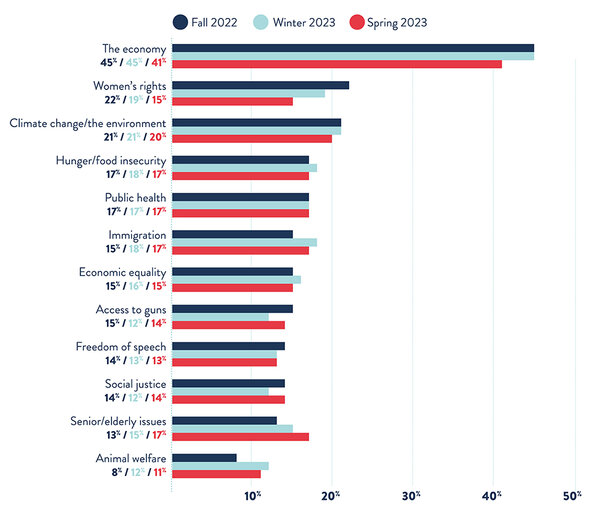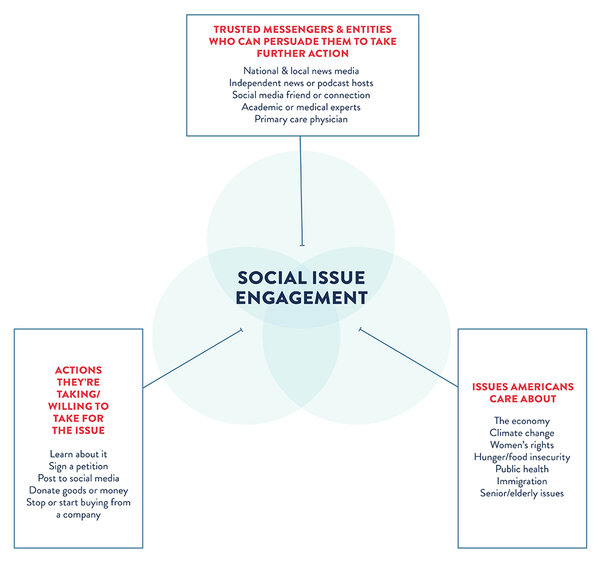How to build an effective social issue campaign amid changing headlines

Americans’ attention is pulled in a thousand different directions by the minute, which makes it nearly impossible to reach and engage them on a particular social issue to get much visibility, much less drive action.
Starting in spring 2022, I led a quarterly survey for the Ad Council Research Institute aimed at understanding the issues Americans care most about, and the actions they take on behalf of those issues. Importantly, the study examines how social issues resonate with Americans—both those receiving large amounts of news coverage and those that do not—so that marketers can inform, persuade, or inspire people to act, either because of or despite the news of the moment.
During the course of the year-long study, Americans’ concerns shifted only slightly—and only somewhat with news headlines. For example, in the wake of the pandemic and with inflation rising, the economy remained the public’s top concern in every quarterly survey. Concern about women’s rights peaked in the summer and fall of 2022 as Roe v. Wade was struck down, though it waned as time went on. And climate change/the environment remained a top-three issue from fall 2022 through spring 2023, with little fluctuation around COP27 and the latest report from the United Nations’ Intergovernmental Panel on Climate Change.
What does this mean for brands and causes? Marketers must understand the changing views and actions of the American public as major moments and movements occur, and the extent to which a particular issue is (or is not) episodic. Some issues have staying power regardless of headlines, while others ebb and flow with the visibility of movements and media coverage.
The other critical piece is targeting the right people. Over the course of this study, we found that the key to issue engagement is precise targeting of not just those who say they care about an issue but also those who are inclined to and prioritize taking action for it—and then creating reasonable levels of engagement based upon the actions everyday Americans are willing to take.
So how do we do this? How do we truly influence Americans to act?
The study identified and analyzed three core areas:
- The issues Americans care about
- The actions Americans take for those issues
- The people/institutions that persuade Americans to take an interest and take action
Together, these elements create the Influencing to Act Engagement Framework.
For the causes and brands seeking to engage the public to address the issues Americans care most about, this framework should become the basis of an effective communications strategy.
When building out a strategy, consider the following:
1. How does this issue connect to the top issues Americans care about?
Since we began this quarterly pulse check in the spring of 2022, Americans’ concerns over some issues have risen and fallen with news headlines, While others have held steady—suggesting some degree of staying power. These are the issues Americans are always somewhat concerned with—and therefore present an opportunity to be addressed.
Over the past year, Americans are/have been most concerned with the economy, climate change/the environment, women’s rights, hunger/food insecurity, public health, immigration, and senior/elderly issues.
In developing a campaign, organizations should consider:
Is the issue seasonal or episodic? Does the public’s attention ebb and flow with news cycles and politics, or is it evergreen?
- Is it top of mind for Americans?
- Does it directly impact their day-to-day lives?
- Conversely, does the impact need to be communicated or illustrated to persuade the public to take an interest in it?
2. What actions are we asking Americans to take?
In each survey, we asked Americans to share the actions they’d taken, if any, in the past 30 to 90 days (timeframe varied by wave) on behalf of the issues they’re most concerned about. The survey included options including passive actions (took time to learn about the issue, signed a petition, posted about the issue on social media) to mid-range actions (donated money or goods to an organization related to the issue) to active actions (participated in a march or rally, volunteered in person, contacted a political representative, started or stopped buying goods because of what the company stands for).
The largest group of respondents consistently said they hadn’t recently taken any action for an issue of top concern. Among actions Americans did take, they were most likely to say they’d:
- taken time to learn about the issue;
- signed a petition;
- posted or shared content on social media;
- donated goods or money to an organization supporting the issue;
- stopped or decreased buying from a company because of their misaligned values; or
- started buying from a company because of their shared values
During campaign development, consider these questions:
- Are we asking the public to take passive actions or to take a more active role?
- Are the actions we want them to take realistic, based upon what we know they’re already doing or are willing to do?
- Why do we think the public would be willing to take these actions?
3. Who are the trusted messengers and entities we need to work with to deliver our calls-to-action?
Within the top issue areas, we asked respondents to share the trusted messengers—that is, the individuals we turn to for honest, unbiased information and trust to help guide decision making and opinions on important issues—as well as individuals and entities they turn to for information about each topic.
Consistently across surveys and regardless of issue, Americans’ trusted messengers and entities of information for top issues was national and local news media (anchors/reporters/personalities). Other most trusted messengers included independent news networks or podcast hosts and a social media friend/connection (Facebook, Instagram, TikTok, etc.). And often, for science- or health-related issues (climate change/the environment, public health), Americans reported turning to experts from academic or medical institutions or their primary care physicians.
During campaign development, consider these questions:
- Who does our target audience turn to and trust for unbiased information on this issue?
- How can we leverage that messenger(s) to deliver more info and persuade the public to act?
Finally, in addition to these three core areas, causes and brands must consider the audience they’re engaging. For those working to effect social change, making an impact can only happen if those who care about issues are also inclined to take action on their behalf.
Over the year of this study, a specific profile emerged of those Americans who are interested in and prioritize taking action on behalf of the social and political issues they care about:
Their demographics:
- 52 percent identify as Democrats
- 44 percent and 36 percent live in suburban or urban areas, respectively
- 39 percent are Gen Z or young millennials (age 18 to 34)
- 39 percent reside in the South
The issues they take action on:
- The economy (36 percent)
- Climate change (28 percent)
- Women’s rights (24 percent)
Actions they’ve taken in the past 90 days:
- Took time to learn about a cause or social issue: 42 percent
- Posted to social media: 37 percent
- Signed a petition: 35 percent
Why they take action:
- The actions of one person can go a long way in making a difference: 95 percent (66 percent said it was a major reason)
- Passionate about an issue: 95 percent (63 percent)
- Feel good about doing something: 93 percent (64 percent)
- Taking action supports their personal well-being: 92 percent (59 percent)n
This triangulation will help leaders identify whom to engage, what issues Americans are most likely to care about and take action for, what actions they should ask Americans to take for those issues, and who should be recruited to help persuade the public to act. By asking the questions and testing campaign initiatives among various audiences, causes and brands can identify an approach that works, and one that will truly reach and influence Americans to take action for today’s top issues.
Derrick Feldmann (@derrickfeldmann) is the founder of the Millennial Impact Project, lead researcher at Cause & Social Influence, and the author of The Corporate Social Mind. See Derrick’s related articles in Philanthropy News Digest, “Nurturing a community for the greatest impact” and “Creating symbiosis between marketing and advocacy.” He also is managing director, Ad Council Research Institute and the Ad Council Edge Strategic Consultancy.







